new posts in all blogs
Viewing: Blog Posts Tagged with: Sharon Zukin, Most Recent at Top [Help]
Results 1 - 10 of 10
How to use this Page
You are viewing the most recent posts tagged with the words: Sharon Zukin in the JacketFlap blog reader. What is a tag? Think of a tag as a keyword or category label. Tags can both help you find posts on JacketFlap.com as well as provide an easy way for you to "remember" and classify posts for later recall. Try adding a tag yourself by clicking "Add a tag" below a post's header. Scroll down through the list of Recent Posts in the left column and click on a post title that sounds interesting. You can view all posts from a specific blog by clicking the Blog name in the right column, or you can click a 'More Posts from this Blog' link in any individual post.

By: Kirsty,
on 11/16/2011
Blog:
OUPblog
(
Login to Add to MyJacketFlap)
JacketFlap tags:
Sociology,
nyc,
new york,
Current Affairs,
Geography,
protest,
Manhattan,
abercrombie,
fitch,
Naked City,
Sharon Zukin,
michael bloomberg,
fifth avenue,
*Featured,
Law & Politics,
Occupy Wall Street,
Zuccotti Park,
zuccotti,
Add a tag
By Sharon Zukin
Until the early morning of November 15, a few hundred Occupy Wall Street protesters spent the chilly nights of a glorious autumn camping out in Lower Manhattan’s Zuccotti Park. Despite Mayor Michael Bloomberg’s disapproval with their politics and under the New York City Police Department’s anxious eye, the occupiers captured public attention in a remarkably peaceful way. Regrouping for the winter, they will take stock of what they have achieved so far and the work that remains.
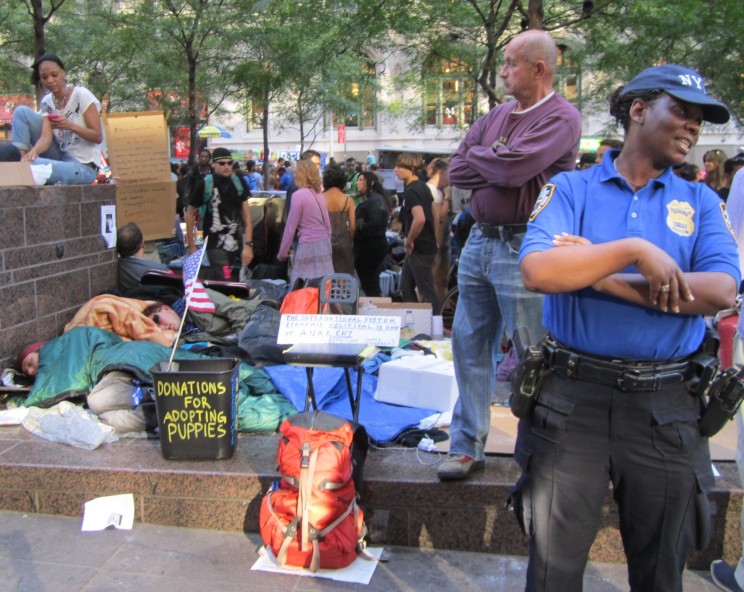
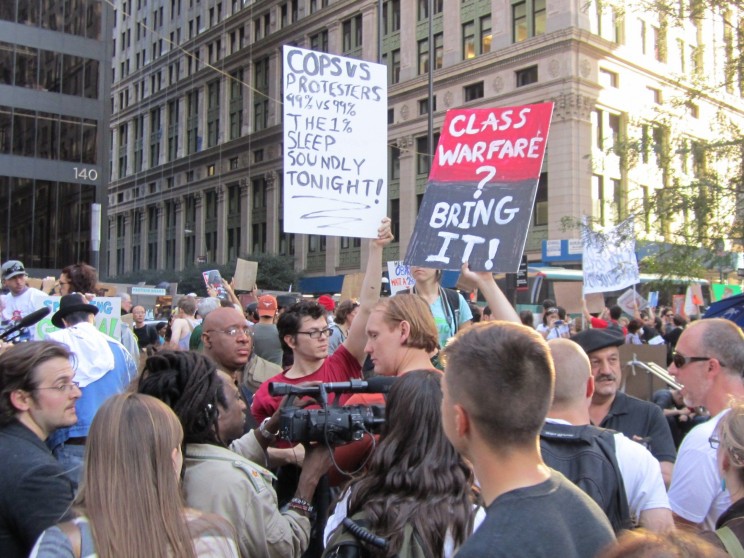
Though the occupation was initially ignored by mainstream media after it began in September, the protest movement attracted favorable attention both nationwide and internationally. Arrests flared in other U.S. cities, notably Oakland, California, where protesters tried to recall a famous general strike of 1946 by marching to the port. But unlike in Oakland, and Portland, Oregon, the encampment at Wall Street survived the constant threat of being rousted by police action on the one hand and cold weather on the other without death, disaster or dishonor.
An official order to clear Zuccotti Park was squelched in October by the intervention of local city council members and other politicians—some of whom, not coincidentally, plan to run for office in the 2012 elections. Many local labor unions support the movement, suggesting that alliances may be possible across “police and firefighter” lines. This kind of alliance recently won a referendum in Ohio overturning a state law that would have limited public unions’ collective bargaining rights.
In Zuccotti Park protesters formed a tiny city within the city. Food, clothing and books were donated and handed out. Electric generators that were confiscated by the fire department were returned after volunteer attorneys complained on the protesters’ behalf. For public safety the occupiers relied on volunteer security guards who used nonviolent techniques to confront, isolate and occasionally expel troublemakers. Women and transgender protesters could, if they wished, sleep in separate tents. Before November 15, few people were arrested by the police for allegedly committing sexual or physical assault.
New Yorkers quickly became accustomed to this remarkably peaceful microcosm of urban life. On sunny weekend afternoons tourists thronged Zuccotti Park and its celebrated neighbors, the World Trade Center site on one side and the financial district on the other. I have never seen Lower Manhattan look more vibrant.
But Occupy Wall Street was only one of Manhattan’s tourist attractions. To put support for the movement’s proposed reforms in a realistic perspective it is suggestive to look at other sites in the city and the desires that they apparently fulfill.
Nearly 50 million men and women are visiting New York City this year. Nearly 50,000 of them ran in the recent New York City Marathon sponsored by ING Bank .
While protesters occupied Zuccotti Park in tents, the average price of a hotel room in New York City is $250 and the hotel occupancy rate is
0 Comments on Memo from Manhattan: Occupying Wall Street—and Fifth Avenue as of 1/1/1900

By: Lauren,
on 9/1/2011
Blog:
OUPblog
(
Login to Add to MyJacketFlap)
JacketFlap tags:
New York City,
Geography,
hurricane,
irene,
waterfront,
Naked City,
Sharon Zukin,
michael bloomberg,
*Featured,
Environmental & Life Sciences,
evacuated,
crowdmap,
developers’,
nycsevereweather,
hurricane’s,
Add a tag
By Sharon Zukin
Everyone knows by now that Tropical Storm Irene, which blew through the East Coast last weekend, flooded the beaches, suburbs and some inland towns but did little lasting damage in New York City. I have seldom felt so lucky to live on a high floor with no river view and on a street with very few trees.


By: Lauren,
on 8/16/2011
Blog:
OUPblog
(
Login to Add to MyJacketFlap)
JacketFlap tags:
*Featured,
studentification,
university place,
urban studies,
Sociology,
New York City,
Geography,
Food & Drink,
greenwich village,
Naked City,
Sharon Zukin,
Add a tag
By Sharon Zukin
E. B. White was correct when he wrote more than sixty years ago that New York is a city of neighborhoods, and he was even more correct that every neighborhood has its own “little main street.” “No matter where you live,” he says, “you will find within a block or two a grocery store, a barbershop, a newsstand and shoeshine shack, an ice-coal-and-wood cellar.., a dry cleaner, a laundry, a delicatessen” and on to the “hardware store, a liquor store, a shoe-repair shop.” Except for the coal


By: Michelle,
on 2/24/2011
Blog:
OUPblog
(
Login to Add to MyJacketFlap)
JacketFlap tags:
*Featured,
Theater & Dance,
Indiana,
budget,
concert,
caption,
Frank Gehry,
Carmel,
attractions,
Naked City,
Sharon Zukin,
Guggenheim Bilbao effect,
McGuggenization,
Palladium,
Current Events,
Geography,
Architecture,
Add a tag
By Michelle Rafferty
When my friend sent me a link with the subject line: Carmel in WSJ! I clicked with trepidation. The last time my hometown made national news it involved a sodomy hazing incident and the high school basketball team. Phew. This time, it was only about a local dispute over an expensive new piece of suburban architecture:
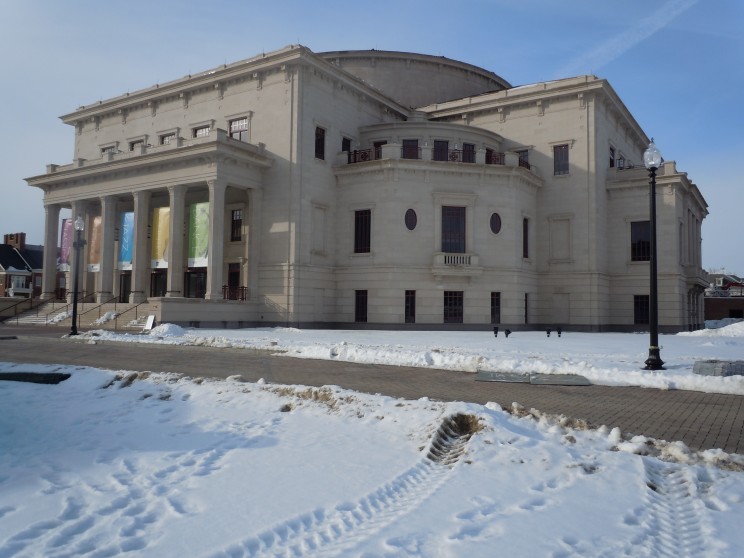
Photo by Melissa Rafferty
This is the Palladium, a $126 million concert hall, whose controversial price tag is heating up this spring’s mayoral election. My first thought was: why, when Indianapolis theater and concert venues reside a mere 20 minutes south, did Carmel do this?* I asked our resident city expert Sharon Zukin for her opinion on the matter and she wrote:
…so Carmel, Indiana, has entered the global sweepstakes of destination culture!…every city copies every bigger, more famous, more glamorous city to build cultural attractions in the hope of attracting tourists and (hope against hope) They hire starchitects (usually Frank Gehry but in this case…the long-dead Andrea Palladio!) to design flagship buildings that will get media attention (the Guggenheim Bilbao effect). They sign up for the Cow Parade (see the website) if they have a low budget and for “The Gates” (Christo in Central Park, 2008) if they have a big budget and for the Olympics if they have a huge budget. All of which puts them on a treadmill of cultural competition.
And the ironic thing is that the more cities compete, trying to differentiate themselves with “cultural attractions,” the more alike they become. As Zukin also told me:
…so many cities do the same thing that they ALL wind up building the same kind of attraction, so the uniqueness of any of these attractions is submerged in the wave of same-old same-old spectacles; the resulting standardization is called, thanks to the geographer Donald McNeil, McGuggenization.
Think of the Guggenheims, Times Squares, MOMA’s, and MOCA’s across the world. That’s McGuggenization. And your city could be next!
*In the Palladium’s defense, I spoke with my mom and she happened to like the center (they offered a free concert for the grand opening). And she didn’t have much sympathy for the outcry about a potential raise in taxes due to Palladium expenses. Turns out Carmel has one of the cheapest tax brackets in the area, meaning the residents have gotten a lot of bang for their buck over their years. Like a brand new Arts & Design District. Safer roads. And Waterslides.

By: Lauren,
on 11/19/2010
Blog:
OUPblog
(
Login to Add to MyJacketFlap)
JacketFlap tags:
Sociology,
Business,
Geography,
las vegas,
luxury,
gambling,
nevada,
Naked City,
Sharon Zukin,
mgm,
casino,
*Featured,
caesars palace,
vegas,
Add a tag
By Sharon Zukin
Taking a position on Las Vegas is like taking an option on a company’s stock: if you like the place, you’re betting that free markets, human power over nature and boundless shopping opportunities will continue to rule the world. If you don’t like it, you’re a killjoy…or a sociologist.
I made my first trip to Las Vegas in early November when the mood in America was sour. Political candidates’ billboards shouted “Not the Incumbent!” and Senate Majority Leader Harry Reid was locked in a nasty battle for re-election against a Tea Party candidate, Sharron Angle. I was prepared to show East Coast tolerance toward libertarians and to be agnostic about the casinos’ glitz and raunch, but I wasn’t prepared for the gigantic scale of the hotels, the almost total absence of a place to stroll along the Strip and the sense that there was no city—no urban “there”–there.
I had expected to find dark romance. What I found was mega-hotels with 3,000 to 4,000 rooms dominating the skyline, multi-story parking garages for hotel guests and staff taking up a large portion of the “backstage” land and a growing reliance on shopping and dining to compensate for declining gaming revenues.
It was all tawdrier than I had imagined. I came looking for James Bond but found suburbia.
Locals told me that when the Forum Shops at the Caesars Palace Hotel and Casino opened in 1992, it was the first high-end shopping center on the Strip and attracted residents as well as tourists. It offers the same luxury brands as any upscale shopping mall, from Gucci and Tumi to 7 for All Mankind and my own New York favorite Scoop (eek!). Until now it hasn’t had much competition, but since the opening of City Center down the Strip in 2009 the Forum looks even less exclusive.
In contrast to the weird appropriations from imagined landscapes that other newish hotels feature—the imagined Venice of the Bellagio, underscaled Eiffel Tower of the Paris Las Vegas and cockeyed iconic structures of New York New York—City Center offers cutting-edge design by some of the best contemporary architects, from Daniel Libeskind and Rafael Viῆoly to Kohn Pedersen Fox. Libeskind’s jagged edges are the “point man” for the project as a whole, fronting the Strip and startling anyone who approaches City Center from the kitsch on either side.
More than a work of public art, though, City Center is a private-sector New Deal for Nevadans. Promoted as a “center of gravity” for a city that has none, this giant construction project contains two luxury hotels (one without a casino, how exclusive is that?), office towers and shopping mall; it cost about $12 billion to build. When it ran over budget and risked being shut down, Senator Reid stepped in to defend it, saving, it is said, 22,000 jobs. Typical for all such projects, City Center benefits from large tax abatements from the state.
Though the critic Paul Goldberger has praised the quality of most of City Center’s buildings and its grand interior spaces, domesticating Libeskind’s wild imagination in a shopping center emphasizes how Las Vegas tends to make everything into an accessory of capital accumulation. More than New York or London or Paris, Vegas is a city shaped by and for economic speculation. Gambling

By: Lauren,
on 10/28/2010
Blog:
OUPblog
(
Login to Add to MyJacketFlap)
JacketFlap tags:
disaster,
flood,
Naked City,
Sharon Zukin,
moma,
Chilean miners,
china,
Sociology,
Politics,
environment,
apocalypse,
Kansas,
Geography,
Featured,
Add a tag
By Sharon Zukin
The world’s biggest cities often spawn disaster scenarios—those end-of-the-world, escape-from-New-York exaggerations of urban dystopia. Once limited to printed texts and paintings, visions of urban apocalypse have become ever more accessible in newspaper photographs, movies and video games. They form a collective urban imaginary, shaping the dark side of local identity and civic pride.
New York is especially attractive as a site of imagined disaster. Maybe it’s payback for the city’s hubris and chutzpah, or perhaps there’s something in the American character that yearns for and fears creative destruction. If there is a general hunger for destruction stories, it is fed by the knowledge that the cities we build are vulnerable. The terrorists’ attacks on the World Trade Center and the Pentagon in 2001 brought this point home to Americans, renewing dormant anxiety about nuclear war and environmental disaster.
But what if the city’s built environment suffers from slow erosion rather than a single cataclysm like Hurricane Katrina? Can we visualize the slow creep of problems as well as we imagine the sudden onset of disaster and summon the will to change course?
“Rising Currents,” a recent exhibition at the Museum of Modern Art, pitted five teams of architects, engineers and urban designers against a gradual but dramatic rise in sea level resulting from global climate change. The challenge: to retrofit the city’s waterfront to survive and prosper after a new Flood.
Cities have a troubled history with water. From building walls around wells in ancient deserts to colonizing rivers for the expansion of trade, human settlements have worn down maritime nature with a steady ooze of cement. Building dams in the West of the United States, India and China, crowding cities near the Danube River in Eastern Europe, throwing landfill into Hong Kong’s Victoria Harbor as well as into New York Bay: all of these have reduced water resources to serve human needs.
Global cities, those capitals of capital, are the biggest offenders. As one of the architectural teams engaged in the MoMA exhibition points out, two piers built for oil depots on the New Jersey side of the Hudson River are each two miles long—as long as the Twin Towers of the old World Trade Center were high.
What’s most impressive about a rising water level is the sense that nature is taking back from the human world. And what’s most impressive about the architectural projects in “Rising Currents” is the sensibility that human survival depends on adaptation rather than pacification.
There are good ideas here. The keywords are conservation, production and conversion: creating a transportation network of ferry boats rather than cars and buses, developing oyster beds off the Brooklyn shore, reshaping fuel depots to use less land. But how can a city government—one whose modest plans for renovating parkland are constantly plagued by cost overruns and delays—undertake these projects?
Privatization is not the answer. Only a state can coordinate long-term efforts to rebuild for urban survival. The recent rescue of the Chilean miners from their underground prison suggests to some people that a non-governmental mobilization of global resources can be successful against great odds. In that case, though, individuals, industries and governments united around one clear goal. To rebuild the waterfront, many conflicts of interest would h

By: Lauren,
on 9/24/2010
Blog:
OUPblog
(
Login to Add to MyJacketFlap)
JacketFlap tags:
ben daniels band,
benjamin kabak,
charles komanoff,
david barash,
geek out,
gelf magazine,
george goethels,
scott allison,
second avenue sagas,
vincent valk,
podcast,
Sociology,
heroes,
A-Featured,
Lexicography,
A-Editor's Picks,
Psychology,
jeopardy,
geeks,
Jesse Sheidlower,
Naked City,
Sharon Zukin,
mta,
The Oxford Comment,
oxford comment,
naked,
jesse,
sheidlower,
lipton,
barash,
judith,
Add a tag
In the second episode of The Oxford Comment, Lauren Appelwick and Michelle Rafferty celebrate geekdom! They interview a Jeopardy champion, talk sex & attraction with a cockatoo, discover what makes an underdog a hero, and “geek out” with some locals.
Subscribe and review this podcast on iTunes!
Featured in this podcast:
Jesse Sheidlower, Editor-at-Large (North America) of the Oxford English Dictionary, author of The F-Word
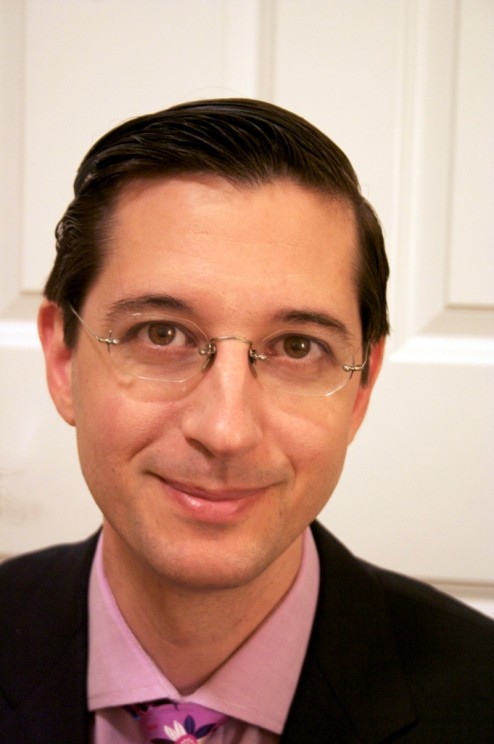

* * * * *
Matt Caporaletti, “Advertising Account Supervisor from Westwood, NJ,” Jeopardy champion
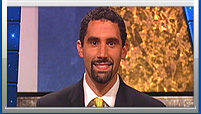
* * * * *
David P. Barash and Judith Lipton authors of Payback: Why We Retaliate, Redirect Aggression, and Take Our Revenge
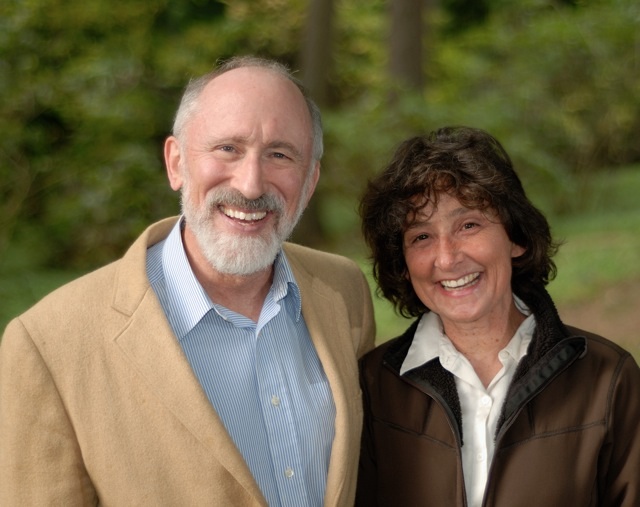
* * * * *
Scott T. Allison and George R. “Al” Goethels, authors of Heroes: What They Do and Why We Need Them. Check out their heroes blog!

By: Lauren,
on 9/23/2010
Blog:
OUPblog
(
Login to Add to MyJacketFlap)
JacketFlap tags:
high line park,
outdoor spaces,
public parks,
Sociology,
New York City,
A-Featured,
bloomberg,
Manhattan,
Sharon Zukin,
Add a tag
By Sharon Zukin
Shortly before 8 p.m. on a warm September evening the High Line, Manhattan’s newest public park and the only one located above street level, is crowded. Men and women, old and young, tourists from overseas and longtime New Yorkers have climbed the winding metal stairs to the former railroad freight line, now a mile-long, landscaped walkway, just to view the sunset over the Hudson River. There are more people up on the High Line than down on the streets. They are taking photos, chatting quietly, lounging on wooden benches and strolling between shallow beds of native plants, creating a new passagiata for the post-industrial city.
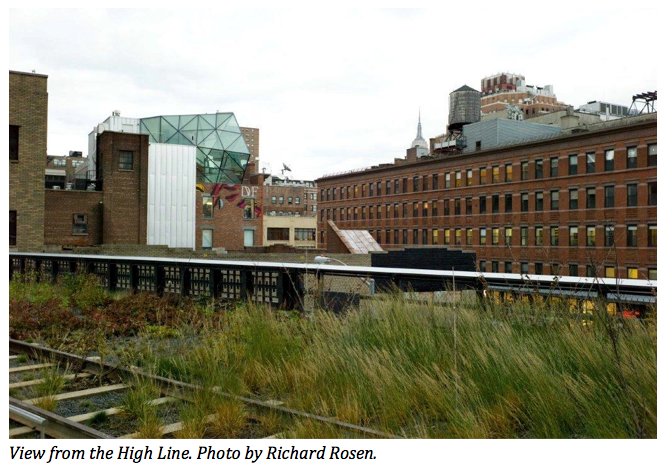 There’s a lot to like about the High Line. It’s a gritty fragment of New York’s industrial past that was saved from demolition by feisty activists and wholesome volunteers. It makes us think about how the city’s architecture was once built for function rather than for style. It reminds us of what the rough West Side of Manhattan was like before a derelict Nabisco plant, where assembly line bakers manufactured the first branded American cracker, was transformed into the high-class bread shops of Chelsea Market. And it recalls the days, not so long ago, when the Meatpacking District was a no-go zone for animal carcasses, blood-stained butchers and several kinds of street workers who made their nocturnal rounds, a far cry from the attraction for club kids and fashionistas it has become.
There’s a lot to like about the High Line. It’s a gritty fragment of New York’s industrial past that was saved from demolition by feisty activists and wholesome volunteers. It makes us think about how the city’s architecture was once built for function rather than for style. It reminds us of what the rough West Side of Manhattan was like before a derelict Nabisco plant, where assembly line bakers manufactured the first branded American cracker, was transformed into the high-class bread shops of Chelsea Market. And it recalls the days, not so long ago, when the Meatpacking District was a no-go zone for animal carcasses, blood-stained butchers and several kinds of street workers who made their nocturnal rounds, a far cry from the attraction for club kids and fashionistas it has become.
The High Line offers New Yorkers a novel way to indulge in two things that have become a passion since 9/11: spending time out-of-doors and hanging out in public spaces. Maybe it reflects a hunger for community or maybe it’s a behavioral response to global warming, but this desire to be together in public flouts the ever-present eye of the surveillance cameras and revels in the diversity of strangers. It’s the same passion that drives apartment dwellers to socialize on their building’s roof and eat lunch in the new “traffic-calming” islands that have been carved out of Broadway’s tumult.
While the number of people who use the city’s public parks has grown enormously in recent years, the High Line attracts a disproportionately huge number of visitors, as many as half a million in the first two months after it opened in 2009.
But this is what it took to “save” it: A mayor – Michael Bloomberg – who understands the value of attractive green space to brand the city for tourists and residents alike. A city planning commissioner, Amanda Burden, who shares the city-branding vision and speaks the language of historic preservation. A longtime strategy of “adaptive re-use” to find new business uses for old historic structures and an emerging strategy of “self-financing” for public parks, both of which rely on private funding. Most important, saving the High Line depended on powerful backers in the “creative class” of art, media and fashion who have their own interest in redeveloping the neighborhood—in this case, the power couple of Diane vo

By: Lauren,
on 9/9/2010
Blog:
OUPblog
(
Login to Add to MyJacketFlap)
JacketFlap tags:
Religion,
Current Events,
Geography,
A-Featured,
9/11,
terrorist,
muslim,
Naked City,
Sharon Zukin,
world trade center,
mosque,
park51,
A-Editor's Picks,
Add a tag
By Sharon Zukin
Of all the mosques, in all the towns, in all the world, why did this mosque cause a furor in this town? I’m speaking about Park51, an Islamic “community center promoting tolerance and understanding,” as its website says, which is being planned to replace an old five-story building in Lower Manhattan that formerly housed a Burlington Coat Factory store with a modern, thirteen-story multi-service facility modeled on Jewish community centers and the YMCA. The burning issue of course is that this location is two blocks from the World Trade Center site where nearly 3,000 men and women died in a terrorist attack on September 11, 2001. A terrorist attack planned and carried out by…Muslims.
But this is New York, for goodness’ sake, which prides itself as – and is often excoriated for being – the most cosmopolitan city in the United States. And it’s not even a mosque, or not exclusively a mosque; it’s a cultural center mainly for Muslims but with an interfaith board of directors, outreach programs for members of the surrounding residential community and a small memorial to the victims of the World Trade Center attack, as well as space for prayer. Park51 is projected to be a place for learning, recreation, and, oh yes, preserving the religious identity of the one million Muslims who live in New York City and the many Muslims who work in Lower Manhattan, some of whose co-religionists—bond traders, street vendors, computer technicians, restaurant workers—were 9/11 victims too.
The plan for Park51, as yet undeveloped and with uncertain funding, won approval this summer from a series of public authorities who have jurisdiction on the matter. From the local community board, an advisory commission that must give its opinion on every change of land use in its district, to the city’s Landmarks Preservation Committee, the city council, and the mayor, every public official declared the project has a right to build in its chosen location. After the controversy broke and the Anti-Defamation League declared its opposition—but before the construction workers’ union said they would not work on the project and President Obama supported American Muslims’ right to worship where they choose (within unspecified political limits), the governor offered to mediate talks about choosing a different location. Apparently a new location might be less insulting to those who feel an Islamic center would defile the “sacred ground” where victims died.
Most New Yorkers would prefer to move Park51 farther from the WTC site but keep it in Lower Manhattan. But they also believe that Muslims have a right to build a mosque wherever they choose; they want Muslims to compromise, not yield their constitutional freedom to worship.
This ambivalence is not surprising. You would think a Muslim center that promotes tolerance would find a home in this most ethnic, most tolerant, most global of cities. But we know from all the controversies that have erupted around rebuilding the World Trade Center site that nothing about this location is either local or normal. Especially not a mosque and not when thousands of Americans are rallying against immigrants of all kinds and “Arabs,” whatever their religion or looks may be, are portrayed as terrorists in both popular films and high-class novels.
Just two weeks ago in midtown a Muslim taxi driver from Bangladesh was slashed by a passenger, an und

By: Michelle,
on 6/22/2010
Blog:
OUPblog
(
Login to Add to MyJacketFlap)
JacketFlap tags:
amsterdam,
Naked City,
Sharon Zukin,
red light district,
urban renewal,
urban sociology,
zukin,
prostitutes,
happening,
podcast,
History,
Sociology,
Art,
new york,
Current Events,
exhibition,
Geography,
A-Featured,
brooklyn,
Architecture,
urban,
sharon,
Add a tag
Michelle Rafferty, Publicity Assistant
The forces of real estate development and rebranding campaigns are transforming urban landscapes around the world─and Sharon Zukin has seen much of it first hand. In the following podcast she explains what happens to the people when a city gains financial capital or decides to change its image. Zukin teaches sociology at Brooklyn College and the City University Graduate Center, and is author of this year’s Naked City: The Death and Life of Authentic Urban Places.
Sharon Zukin: The basic industry of New York has been real estate for many years—the selling of land, the building of more expensive offices and apartments to replace the buildings that came before. This is just an unrecognized, really big part of New York City. New money from bigger investors comes in and drives out the people who are still paying low rents.
Michelle Rafferty: So Manhattan has become a place where many people who work in the city can’t actually afford to live there. Where else do you see this happening in the world, and how do we know when a city is on its way to becoming more elite or less diverse in terms of class?
Zukin: In every city of the world where the center of the city is redeveloped for the financial class and welcomes expatriates and transnational investors, that’s where the local population is being kicked out to the edges of the city. Yes it’s happened in New York, but it’s also happening in Shanghai. Yes it has happened in London, and Paris, but it’s also happening in Nam Ping. The centers of the city, in contrast to the 1960s and 70s have become valuable again. They’re valuable financially, they’re valuable logistically, they’re valuable culturally.
Rafferty: You just were talking about other cities in the world and I know you travel a lot. You get to see how a lot of other cities are changing, compare those changes to New York City. I know recently you went to Amsterdam, and specifically you saw what was going on in the Red Light District. I’m wondering if you can talk about that a little bit more, how that area is changing.
Zukin: The Red Light District has begun to look like a serious disadvantage for marketing Amsterdam. There’s even a kind of “I Love Amsterdam” campaign that copies the “I Love New York” campaign of the past few decades. So the new marketing of Amsterdam is more family friendly and really can’t deal with the drug traffic and the human trafficking of the sex industry. So there’s an attempt to evict those uses of the space and turn the windows of the brothels at least temporarily over to fashion designers and visual artists who display their work in the shop windows.
There was a very interesting exhibition at the Amsterdam Historical Museum this year that shows Ed Kienholz’s installations that reproduce the interiors of some of the very sordid rooms of the prostitutes of the Red Light District. But the exhibition also documents–in video form and in printed interviews–the desires of many of the prostitutes to continue working in the center of Amsterdam. There’s a curious dynamic of women’s control over their bodies and their work in a legalized prostitution situation, and the criminality of a lot of that industry, all of which is played out in urban redevelopment.










